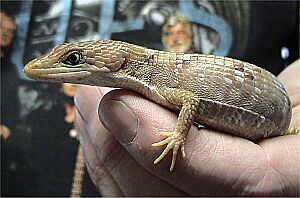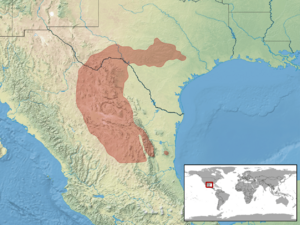Texas alligator lizard facts for kids
Quick facts for kids Texas alligator lizard |
|
|---|---|
 |
|
| Texas Alligator Lizard, Gerrhonotus infernalis |
|
| Conservation status | |
| Scientific classification | |
| Genus: |
Gerrhonotus
|
| Species: |
infernalis
|
 |
|
| Synonyms | |
|
|
The Texas alligator lizard (Gerrhonotus infernalis) is a cool type of lizard found only in a special part of Texas in the United States, and a bit into northern Mexico. It belongs to a group of lizards called Anguidae, known for their tough scales.
Contents
About the Texas Alligator Lizard
The Texas alligator lizard is a medium-sized lizard. It can grow to be about 24 to 25 in (61 to 64 cm) long, including its tail. This makes it the largest lizard species in Texas! It's also one of the biggest alligator lizards anywhere.
This lizard has a flat head shaped like a wedge. Its body is usually a yellow-brown color. Often, it has darker brown and white checker patterns on its back. Its belly is usually a light color, like white or grey.
Cool Features of This Lizard
The scales of the Texas alligator lizard are very stiff and feel like plates. It has short legs. A neat trick it has is that its tail can break off if a predator tries to catch it. This helps the lizard escape! Don't worry, the tail will grow back over time.
When they are newly hatched, these lizards are a deep metallic brown. They have clear white stripes across their bodies. As they get older, their colors change. Adult lizards can be tan-yellowish or reddish-brown. They have about eight to ten lighter stripes on their backs. The head and belly usually don't have any marks.
Behavior of the Texas Alligator Lizard
The Texas alligator lizard is a fairly slow lizard. It is active during the day, which means it's a diurnal animal. It also has very good eyesight.
Even though it's not usually aggressive, it might bite if someone tries to pick it up. Some people mistakenly think these lizards are venomous, but they are not.
Where the Texas Alligator Lizard Lives
You can often find G. infernalis on rocky hillsides. They like to hide among the stones or in cracks in limestone rocks. Even in places they love, they are not seen very often. The Texas alligator lizard lives in the Edwards Plateau area of Central Texas. Its home range also stretches south into eastern Mexico.
What the Texas Alligator Lizard Eats
The Texas alligator lizard mostly eats insects and other small creatures without backbones, called invertebrates. Sometimes, it might also hunt and eat baby birds or small rodents.
Reproduction and Life Cycle
Texas alligator lizards can breed all year long. A female lizard might lay several groups of eggs in one year. She often stays close to her nest to protect the eggs. However, once the baby lizards hatch, the mother does not take care of them.
The young alligator lizards are usually about 3–4 in (7.6–10.2 cm) long when they hatch, including their tails. They often have brighter and more noticeable markings than the adults.


